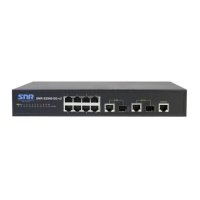SNR S2940-8G-v2 Switch Configuration Guide
Basic Switch Configuration
[Boot]: boot img nos.img primary
flash:/nos.img will be used as the primary img file at the next time!
[Boot]: show boot-files
The primary img file : flash:/nos.img
The backup img file : flash:/nos.img
The startup-config file: NULL
[Boot]:
2.5.3 FTP/TFTP Upgrade
Introduction to FTP/TFTP
FTP(File Transfer Protocol)/TFTP(Trivial File Transfer Protocol) are both file transfer protocols that
belonging to fourth layer(application layer) of the TCP/IP protocol stack, used for transferring files
between hosts, hosts and switches. Both of them transfer files in a client-server model. Their
differences are listed below.
FTP builds upon TCP to provide reliable connection-oriented data stream transfer service.
However, it does not provide file access authorization and uses simple authentication mechanism
(transfers username and password in plain text for authentication). When using FTP to transfer
files, two connections need to be established between the client and the server: a management
connection and a data connection. A transfer request should be sent by the FTP client to establish
management connection on port 21 in the server, and negotiate a data connection through the
management connection.
There are two types of data connections: active connection and passive connection.
In active connection, the client transmits its address and port number for data transmission to
the server, the management connection maintains until data transfer is complete. Then, using the
address and port number provided by the client, the server establishes data connection on port 20
(if not engaged) to transfer data; if port 20 is engaged, the server automatically generates some
other port number to establish data connection.
In passive connection, the client, through management connection, notify the server to estab-
lish a passive connection. The server then creates its own data listening port and informs the
client about the port, and the client establishes data connection to the specified port.
As data connection is established through the specified address and port, there is a third party
to provide data connection service.
TFTP builds upon UDP, providing unreliable data stream transfer service with no user authen-
tication or permission-based file access authorization. It ensures correct data transmission by
sending and acknowledging mechanism and retransmission of time-out packets. The advantage
of TFTP over FTP is that it is a simple and low overhead file transfer service.
Switch can operate as either FTP/TFTP client or server. When switch operates as a FTP/TFTP
client, configuration files or system files can be downloaded from the remote FTP/TFTP servers
(can be hosts or other switches) without affecting its normal operation. And file list can also be
retrieved from the server in ftp client mode. Of course, switch can also upload current configuration
files or system files to the remote FTP/TFTP servers (can be hosts or other switches). When switch
operates as a FTP/TFTP server, it can provide file upload and download service for authorized
38

